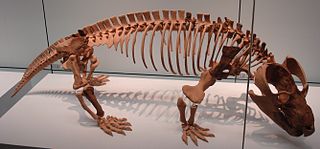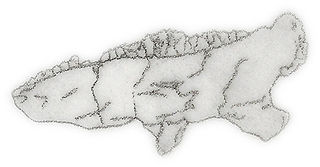Related Research Articles

Mammals are a group of vertebrate animals constituting the class Mammalia, and characterized by the presence of mammary glands which in females produce milk for feeding (nursing) their young, a neocortex, fur or hair, and three middle ear bones. These characteristics distinguish them from reptiles and birds, from which they diverged in the Carboniferous, over 300 million years ago. Around 6,400 extant species of mammals have been described. The largest orders are the rodents, bats and Eulipotyphla. The next three are the Primates, the Artiodactyla, and the Carnivora.

Marsupials are any members of the mammalian infraclass Marsupialia. All extant marsupials are endemic to Australasia and the Americas. A distinctive characteristic common to most of these species is that the young are carried in a pouch. Well-known marsupials include kangaroos, wallabies, koalas, opossums, wombats, Tasmanian devils, and the extinct thylacine. Some lesser-known marsupials are the dunnarts, potoroos, and the cuscus.

Synapsids are a group of animals that includes mammals and every animal more closely related to mammals than to the other members of the amniote clade, such as reptiles and birds. They are easily separated from other amniotes by having a temporal fenestra, an opening low in the skull roof behind each eye, leaving a bony arch beneath each; this accounts for their name. Primitive synapsids are usually called pelycosaurs or pelycosaur-grade synapsids. This informal term consists of all synapsids that are not therapsids, a monophyletic, more advanced, mammal-like group. The non-mammalian synapsids were described as mammal-like reptiles in classical systematics, but this misleading terminology is no longer in use as synapsids as a whole are no longer considered reptiles. They are now more correctly referred to as stem mammals or proto-mammals. Synapsids evolved from basal amniotes and are one of the two major groups of amniotes, the other being the sauropsids, the group that includes reptiles and birds. The distinctive temporal fenestra developed in the ancestral synapsid about 312 million years ago, during the Late Carboniferous period.

Therapsida is a major group of eupelycosaurian synapsids that includes mammals and their ancestors. Many of the traits today seen as unique to mammals had their origin within early therapsids, including limbs that were oriented more underneath the body, as opposed to the sprawling posture of many reptiles and salamanders. The earliest fossil attributed to Therapsida used to be Tetraceratops insignis from the Lower Permian. However in 2020, a new study has found that Tetraceratops is not actually a true Therapsid, but should be considered to be a member of the more ancient Sphenacodontia from which the therapsids evolved.

The cynodonts are a clade of therapsids that first appeared in the Late Permian, and extensively diversified after the Permian–Triassic extinction event. Cynodonts had a wide variety of lifestyles, including carnivory and herbivory. Mammals are cynodonts, as are their extinct ancestors and close relatives, having evolved from advanced probainognathian cynodonts during the Late Triassic. All other cynodont lines went extinct, with the last known non-mammalian cynodont group, the Tritylodontidae having its last records in the Early Cretaceous.
The lignans are a large group of low molecular weight polyphenols found in plants, particularly seeds, whole grains, and vegetables. The name derives from the Latin word for "wood". Lignans are precursors to phytoestrogens. They may play a role as antifeedants in the defense of seeds and plants against herbivores.
Hadrocodium wui is an extinct mammaliaform that lived during the Sinemurian stage of the Early Jurassic approximately 195 million years ago in the Lufeng Formation of the Lufeng Basin in what is now the Yunnan province in south-western China (25.2°N 102.1°E, paleocoordinates 34.3°N 104.9°E).

Aetosaurs are an extinct order of heavily armoured, medium- to large-sized Late Triassic herbivorous archosaurs. They have small heads, upturned snouts, erect limbs, and a body covered by plate-like scutes. All aetosaurs belong to the family Stagonolepididae. Two distinct subdivisions of aetosaurs are currently recognized, Desmatosuchinae and Aetosaurinae, based primarily on differences in the morphology of the bony scutes of the two groups. Over 20 genera of aetosaurs have been described, and recently there has been controversy regarding the description of some of these genera.

Tatisaurus is a genus of ornithischian dinosaur from the Early Jurassic from the Lower Lufeng Formation in Yunnan Province in China. Little is known as the remains are fragmentary. The type species is T. oehleri.

Yanoconodon is a monotypic genus of extinct early mammal whose representative species Yanoconodon allini lived during the Mesozoic in what is now China. The holotype fossil of Yanoconodon was excavated in the Yan Mountains about 300 kilometres from Beijing in the Qiaotou member of the Huajiying Formation of Hebei Province, China, and is therefore of uncertain age. The Qiaotou Member may correlate with the more well-known Early Cretaceous Yixian Formation, and so probably dates to around 122 Ma ago.
Diarthrognathus is an extinct genus of tritheledontid cynodonts, known from fossil evidence found in South Africa and first described in 1958 by A.W. Crompton. The creature lived during the Early Jurassic period, about 200 million years ago. It was carnivorous and small, slightly smaller than Thrinaxodon, which was under 50 centimetres (20 in) long.

The evolution of mammalian auditory ossicles was an evolutionary event that resulted in the formation of the bones of the mammalian middle ear. These bones, or ossicles, are a defining characteristic of all mammals. The event is well-documented and important as a demonstration of transitional forms and exaptation, the re-purposing of existing structures during evolution.

Ralph Lawrence Brinster is an American geneticist, National Medal of Science laureate, and Richard King Mellon Professor of Reproductive Physiology at the School of Veterinary Medicine, University of Pennsylvania.
In paleontology, biochronology is the correlation in time of biological events using fossils. In its strict sense, it refers to the use of assemblages of fossils that are not tied to stratigraphic sections. Collections of land mammal ages have been defined for every continent except Antarctica, and most are correlated with each other indirectly through known evolutionary lineages. A combination of argon–argon dating and magnetic stratigraphy allows a direct temporal comparison of terrestrial events with climate variations and mass extinctions.
Color vision, a proximate adaptation of the vision sensory modality, allows for the discrimination of light based on its wavelength components.
Chronoperates is an extinct genus of mammal whose remains have been found in a late Paleocene deposit in Alberta, Canada. It is represented by the type species Chronoperates paradoxus and known only from a partial left lower jaw. It was first identified in 1992 as a non-mammalian cynodont, implying a ghost lineage of over 100 million years since the previously youngest known record of non-mammalian cynodonts, which at that time was in the Jurassic period. Subsequent authors have challenged this interpretation, particularly as the teeth do not resemble any known non-mammalian cynodonts. Chronoperates is now generally considered to be more likely to be a late-surviving symmetrodont mammal. This would still infer a ghost lineage for symmetrodonts, but a more plausible one, as symmetrodonts persisted into the Late Cretaceous.

Female is the sex of an organism, or a part of an organism, that produces non-mobile ova. Barring rare medical conditions, most female mammals, including female humans, have two X chromosomes. Female characteristics vary between different species with some species containing more well defined female characteristics, such as the presence of pronounced mammary glands. There is no single genetic mechanism behind sex differences in different species and the existence of two sexes seems to have evolved multiple times independently in different evolutionary lineages.

Monotremes are one of the three main groups of living mammals, along with placentals (Eutheria) and marsupials (Metatheria). The monotremes are typified by structural differences in their brains, jaws, digestive tract, reproductive tract, and other body parts compared to the more common mammalian types. In addition, they lay eggs rather than bearing live young, but, like all mammals, the female monotremes nurse their young with milk.
Mesorhinosuchus is an extinct genus of basal phytosaur possibly known from the Early Triassic of Saxony-Anhalt, central-eastern Germany. It was first named by Otto Jaekel in 1910 and the type species is Mesorhinus fraasi. The generic name Mesorhinus was preoccupied by Mesorhinus piramydatus Ameghino, 1885, a macraucheniid meridiungulatan mammal. Thus, an alternative generic name, Mesorhinosuchus, was proposed by Oskar Kuhn in 1961. The genus is occasionally misspelled as Mesorhinosaurus, while Stocker and Butler (2013) recently misspelled its original generic name as Mesosuchus.
Alpha-gal allergy — or mammalian meat allergy (MMA) — is a type of red-meat allergy characterized by a delayed onset of symptoms after ingesting the provoking food and resulting from past exposure to tick bites. It was first reported in 2002.
References
- North American Mammalian Time Scale Retrieved June 18, 2007
Notes
- ↑ "Biochronology and biochron boundaries: A real dilemma or a false problem? An example based on the Pleistocene large mammalian faunas from Italy". ResearchGate. Retrieved May 10, 2017.
| | This paleontology article is a stub. You can help Wikipedia by expanding it. |